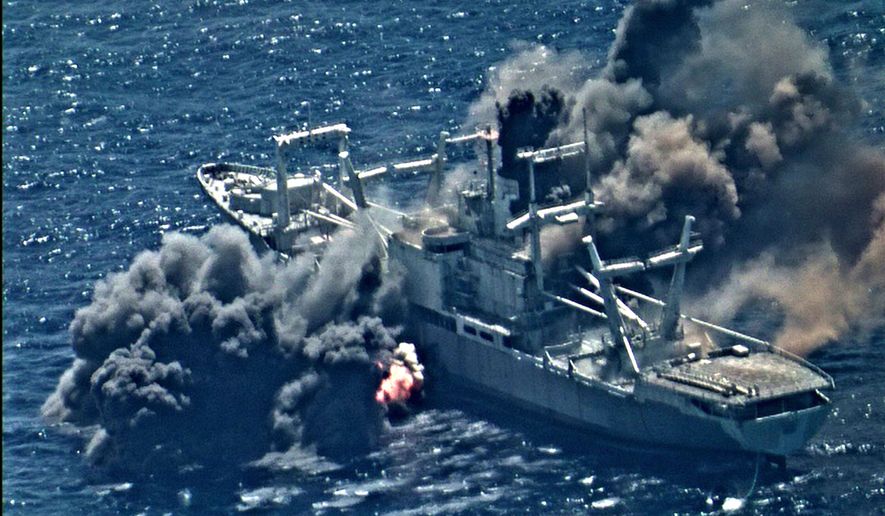The U.S. Navy and its allies this week used a decommissioned American ship as target practice during a major Pacific military exercise, launching missiles from the air and sea to demolish and sink the vessel.
Planes and ships from the U.S., Australia and other partner nations turned their fire on the retired Navy ship USS Durham on Sunday. The Navy released dramatic photos and video that show the ship engulfed by fire and smoke after being hit by a barrage of missiles, torpedoes, and other weapons.
The sinking exercise was part of the annual Rim of the Pacific event, or RIMPAC, the world’s largest set of multilateral maritime drills.
“Simulation is a critical part of our training, but there is nothing better than to conduct live fire training,” said Royal Australian Navy Capt. Phillipa Hay, commander of the RIMPAC 2020 Task Force One. “Sinking exercises are an important way to test our weapons and weapons systems in the most realistic way possible. It demonstrates as a joint force we are capable of high-end warfare.”
Making it REAL!
— U.S. Navy (@USNavy) August 31, 2020
Live fire from ships and aircraft participating in #RIMPAC 2020, sink the ex-USS Durham (LKA 114), while providing a realistic training opportunity, August 30th: #CapableAdaptivePartners @RimofthePacific
DETAILS: ⬇️ https://t.co/igv4ScyAn6 pic.twitter.com/a4INpaOS0t
Ten countries took part in this year’s RIMPAC. The event has taken on extra geopolitical significance in recent years because of rising tensions between Washington and Beijing. China’s military has taken part in RIMPAC in past years but was formally disinvited by the Pentagon in 2018 over U.S. objections to Beijing’s militarization of the South China Sea.
In addition to the U.S., this year’s participants were: Australia, Brunei, Canada, France, Japan, New Zealand, the Philippines, South Korea and Singapore.
“Our formidable team of capable, adaptive partners has spent the last two weeks demonstrating that we have the resolve and ability to operate together in these challenging times,” Vice Adm. Scott Conn, commander of the U.S. 3rd Fleet, said in a statement marking the end of RIMPAC. “We strengthened relationships and deepened our sense of trust in one another. Each one of our navies has something to offer and that diverse range of knowledge and professionalism is what makes us stronger, and allows us to work together to ensure a free and open Indo-Pacific and ultimately, our collective prosperity.”
Navy officials said they followed strict environmental guidelines when sinking the Durham. The ship was sunk in an area at least 6,000 feet deep and 50 nautical miles from land, and the Navy conducted surveys ahead of the event to ensure no humans or marine mammals would be harmed.
The ship also was put through a thorough cleaning process to remove liquid polychlorinated biphenyls and all other potentially harmful materials.
• Ben Wolfgang can be reached at bwolfgang@washingtontimes.com.




Please read our comment policy before commenting.